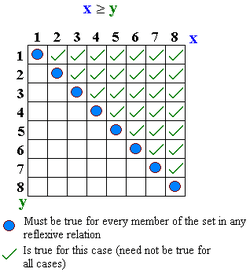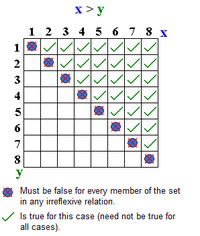Reflexive relation
In mathematics, a binary relation R over a set X is reflexive if it relates every element of X to itself.[1][2] Formally, this may be written ∀x ∈ X : x R x, or as I ⊆ R where I is the identity relation on X.
An example of a reflexive relation is the relation "is equal to" on the set of real numbers, since every real number is equal to itself. A reflexive relation is said to have the reflexive property or is said to possess reflexivity. Along with symmetry and transitivity, reflexivity is one of three properties defining equivalence relations.
Related terms
A binary relation is called irreflexive, or anti-reflexive, if it doesn't relate any element to itself. An example is the "greater than" relation (x > y) on the real numbers. Not every relation which is not reflexive is irreflexive; it is possible to define relations where some elements are related to themselves but others are not (i.e., neither all nor none are). For example, the binary relation "the product of x and y is even" is reflexive on the set of even numbers, irreflexive on the set of odd numbers, and neither reflexive nor irreflexive on the set of natural numbers. However, a relation is irreflexive if, and only if, its complement is reflexive.
A relation ~ on a set X is called quasi-reflexive if every element that is related to some element is also related to itself, formally: ∀ x, y ∈ X : x ~ y ⇒ (x ~ x ∧ y ~ y). An example is the relation "has the same limit as" on the set of sequences of real numbers: not every sequence has a limit, and thus the relation is not reflexive, but if a sequence has the same limit as some sequence, then it has the same limit as itself. It does make sense to distinguish left and right quasi-reflexivity, defined by ∀ x, y ∈ X : x ~ y ⇒ x ~ x[3] and ∀ x, y ∈ X : x ~ y ⇒ y ~ y, respectively. For example, a left Euclidean relation is always left, but not necessarily right, quasi-reflexive. A relation R is quasi-reflexive if, and only if, its symmetric closure R∪RT is left (or right) quasi-reflexive.
A relation ~ on a set X is called coreflexive if for all x and y in X it holds that if x ~ y then x = y.[4] An example of a coreflexive relation is the relation on integers in which each odd number is related to itself and there are no other relations. The equality relation is the only example of a both reflexive and coreflexive relation, and any coreflexive relation is a subset of the identity relation. The union of a coreflexive and a transitive relation is always transitive. A relation R is coreflexive if, and only if, its symmetric closure is anti-symmetric.
A reflexive relation on a nonempty set X can neither be irreflexive, nor asymmetric, nor antitransitive.
The reflexive closure ≃ of a binary relation ~ on a set X is the smallest reflexive relation on X that is a superset of ~. Equivalently, it is the union of ~ and the identity relation on X, formally: (≃) = (~) ∪ (=). For example, the reflexive closure of (<) is (≤).
The reflexive reduction, or irreflexive kernel, of a binary relation ~ on a set X is the smallest relation ≆ such that ≆ shares the same reflexive closure as ~. It can be seen in a way as the opposite of the reflexive closure. It is equivalent to the complement of the identity relation on X with regard to ~, formally: (≆) = (~) \ (=). That is, it is equivalent to ~ except for where x~x is true. For example, the reflexive reduction of (≤) is (<).
Examples


Examples of reflexive relations include:
- "is equal to" (equality)
- "is a subset of" (set inclusion)
- "divides" (divisibility)
- "is greater than or equal to"
- "is less than or equal to"
Examples of irreflexive relations include:
- "is not equal to"
- "is coprime to" (for the integers>1, since 1 is coprime to itself)
- "is a proper subset of"
- "is greater than"
- "is less than"
Number of reflexive relations
The number of reflexive relations on an n-element set is 2n2−n.[5]
| Elements | Any | Transitive | Reflexive | Preorder | Partial order | Total preorder | Total order | Equivalence relation |
|---|---|---|---|---|---|---|---|---|
| 0 | 1 | 1 | 1 | 1 | 1 | 1 | 1 | 1 |
| 1 | 2 | 2 | 1 | 1 | 1 | 1 | 1 | 1 |
| 2 | 16 | 13 | 4 | 4 | 3 | 3 | 2 | 2 |
| 3 | 512 | 171 | 64 | 29 | 19 | 13 | 6 | 5 |
| 4 | 65,536 | 3,994 | 4,096 | 355 | 219 | 75 | 24 | 15 |
| n | 2n2 | 2n2−n | ∑n k=0 k! S(n, k) |
n! | ∑n k=0 S(n, k) | |||
| OEIS | A002416 | A006905 | A053763 | A000798 | A001035 | A000670 | A000142 | A000110 |
Philosophical logic
Authors in philosophical logic often use different terminology. Reflexive relations in the mathematical sense are called totally reflexive in philosophical logic, and quasi-reflexive relations are called reflexive.[6][7]
Notes
- Levy 1979:74
- Relational Mathematics, 2010
- The Encyclopedia Britannica calls this property quasi-reflexivity.
- Fonseca de Oliveira, J. N., & Pereira Cunha Rodrigues, C. D. J. (2004). Transposing Relations: From Maybe Functions to Hash Tables. In Mathematics of Program Construction (p. 337).
- On-Line Encyclopedia of Integer Sequences A053763
- Alan Hausman; Howard Kahane; Paul Tidman (2013). Logic and Philosophy — A Modern Introduction. Wadsworth. ISBN 1-133-05000-X. Here: p.327-328
- D.S. Clarke; Richard Behling (1998). Deductive Logic — An Introduction to Evaluation Techniques and Logical Theory. University Press of America. ISBN 0-7618-0922-8. Here: p.187
References
- Levy, A. (1979) Basic Set Theory, Perspectives in Mathematical Logic, Springer-Verlag. Reprinted 2002, Dover. ISBN 0-486-42079-5
- Lidl, R. and Pilz, G. (1998). Applied abstract algebra, Undergraduate Texts in Mathematics, Springer-Verlag. ISBN 0-387-98290-6
- Quine, W. V. (1951). Mathematical Logic, Revised Edition. Reprinted 2003, Harvard University Press. ISBN 0-674-55451-5
- Gunther Schmidt, 2010. Relational Mathematics. Cambridge University Press, ISBN 978-0-521-76268-7.
External links
- "Reflexivity", Encyclopedia of Mathematics, EMS Press, 2001 [1994]